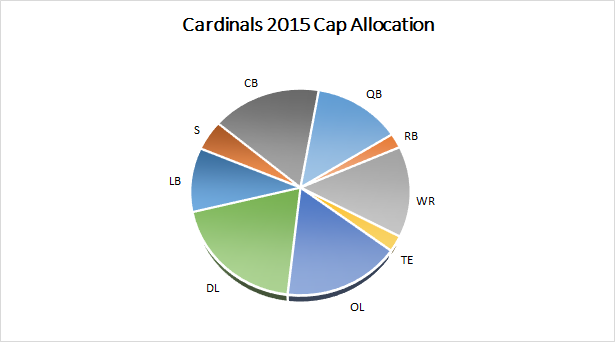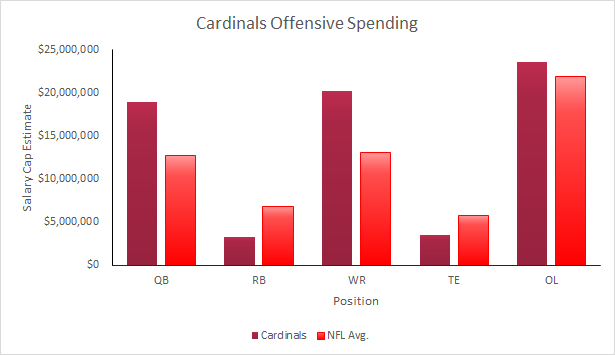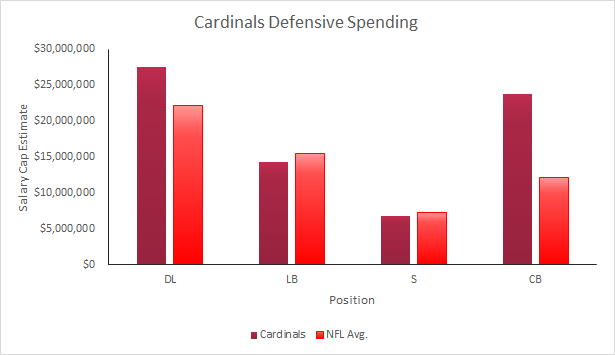Expected Contract Outcomes – Expected Contract Value 2.0 utilizes an algorithm based on a player’s contract characteristics, age, position and 2015 performance to forecast probabilities as to the outcomes of contract termination decisions. The lower the Expected Outcome, the more likely the player’s contract will be terminated in 2016. A pay cut is treated as a termination. We have applied ECV 2.0 to all contracts scheduled to count $2 million or more against the 2016 salary cap with the exception of exercised 5th year rookie options. Expected Savings is the calculated by multiplying the probability a player will be released by the cap savings realized by the team upon such release.
Arizona Cardinals
Cardinals 2015 Salary Cap Outlook
Estimated 2015 Cap Space: $4M ($143M cap limit)
Roster Overview
Players Under Contract: 63
Pro Bowlers: 3
Unrestricted Free Agents: 10(3 with 50%+ playtime)
Draft Selection: 24
Salary Cap Breakdown
Free Agents to Re-sign
The Cardinals should make an early attempt to re-sign Dan Williams to man the center of the defensive line before a team like the Redskins comes in and steals him. Williams should have more value to Arizona than most teams because they are playing in what has become a run heavy conference and Williams is terrific at clogging the middle on those plays. The 34DT has not been a prime pay position so he should be able to be retained on a reasonable salary…Sam Acho is one of those quality role players who are worth keeping on a good unit, which clearly the Cardinals have. My guess is he would test free agency first….Tommy Kelly played well and as long as he comes cheap, which he should at this stage, he will be a good signing for the team.
Free Agents to Let Walk
Antonio Cromartie had a nice bounce back season with Arizona but with Todd Bowles landing in his old stomping grounds in New York it is probably not worth wasting the resources chasing after him and losing focus on others…Paul Fanaika will come back for around the minimum, but he did not play particularly well last season and I would imagine this is more of a position to address in the draft where you hope to find more upside.
Contracts to Modify
The Cardinals got the biggest one out of the way with their renegotiation with Larry Fitzgerald but there is clearly more work that needs to be done if they want to be active in free agency. The team has four players with large base salaries that could be restructured but I would avoid touching the contracts of Patrick Peterson, Carson Palmer, and Calais Campbell due to future concerns with the players. The safest move looks to be restructuring the contract of Jared Veldheer. Veldheer has an $8.5 million cap charge and the team could reduce that by nearly $5 million with a full restructure. His cap in the future still would not exceed $10 million if they reworked his deal so I think he is a logical choice for cap relief. If they need more down the line expect Peterson to be the one to get the call….Darnell Dockett has a $9.8 million cap charge in 2015, which is excessive for a 34 year old defensive tackle coming off injury. My head says to release him outright and gain $6.8 million in space, but listening to the organization talk about him my heart says they want to keep him. If they reduce his salary to $2-$3 million they will gain between $3.5 and $4.5 million in room.
Players to Consider Releasing
There will likely be a purge of the mid tier salary guys this offseason. Right at the top of that list should be Ted Ginn. $4 million in cap charges for a punt returner who brings nothing else to the team simply can’t happen in 2015. Releasing Ginn creates $2.5 million in cap room….Cutting guard Lyle Sendlein, rated as one of the worst lineman in the NFL by PFF, saves the team $3.15 million…I’m not sure what the team saw in John Carlson when they signed him, but they should have seen enough to realize that saving $1.6 million is more valuable than keeping him…The team might have an interesting decision to make on backup QB Drew Stanton. If Palmer is healthy and the team believes in Logan Thomas there is no need to keep $3.87 million in cap charges for a player who could be the third string QB. If that’s the case Stanton might have some trade value…Players like Ted Larsen($2.2M savings), Matt Shaughnessy($2.075M), and Rashad Johnson($1.9M) could be casualties depending on who the team lands in free agency or the draft….I’m sure the team will consider every option with Daryl Washington but they won’t really gain anything by releasing him. I’m not certain of the payment schedule of his prior bonus money but they may view this as a free year if they need to recollect bonus money that he forfeited with last year’s suspension.
Offseason Plan
The Cardinal quarterback injuries derailed a great season in 2014 and they will expect less issues there this season. I think that the new Fitzgerald contract puts into focus the short term goals of the team right now. It was a decision that was likely driven by pure cap considerations (with some emotion clearly in there). Had they released Fitzgerald they would have taken a $14.4M dead cap charge this season, but by re-signing him they will carry $26.7M over two years, and just $10.85M this season. The difference works out to a $6M player which is basically what Fitzgerald is now. So they are sacrificing cash for cap considerations with the move.
The Cardinals are a veteran team with a 36 year old QB and when you have that you do whatever you can to win now because that window of opportunity may be very small. While I would not rework the contracts of certain players, I would not be surprised if they do it because their goal is going to be immediate improvement which usually is best accomplished in free agency.
The team should be going into the offseason and setting up a board that identifies what can be filled in free agency and what can be filled in the draft and making sure a plan is made to hit as many immediate needs as possible. Depending on how much cap room they create they likely can find a running back, tight end, and guard in free agency. Those are positions that they can likely slot right into the rotation and are also relatively affordable.
I think in the draft they should focus on getting more youth on defense. An inside linebacker can come from the draft and jump right in and play at a reasonably high level. They can probably find a defensive end or outside linebacker to work into the rotation as well. They may find another offensive lineman in the draft too, but I see the team focusing on defense here with an offensive talent needing a far higher internal grade to get the nod when drafting.
The bottom line is that the Cardinals are a team that needs to go for it in 2015 and take a risky approach to add onto what they had in 2014 to hopefully get them to the next level. With the team going all in on Fitzgerald and Palmer they have no reason to not do everything in their power to try to reach for the gold this year. While it may not work, and sometimes these types of teams crash and burn, they will likely regret not making a few semi-bold moves this offseason.
Cardinals Links
Cardinals GM Salary Cap Calculator
A Look at Carson Palmer’s Contract
[adsenseyu1]
Obviously I had a lot of questions about Carson Palmer following his injury and in light of a report by Albert Breer concerning Palmer’s contract I think I can discuss it a bit more intelligently at this point.
Here’s the full deal … ’14: $6.5M sb, $3.5 rb; ’15: $1M base, $9.5M rb; ’16: $6.35M base, $6.35M rb; ’17: $8.15M base, $8.15M rb.
— Albert Breer (@AlbertBreer) November 10, 2014
Palmer’s new contract looks to be worth $49.5 million over three seasons. Of that $49.5 million he will receive $10 million this year, money that should all be treated as a signing bonus. That is the number I projected the other day as a reasonable figure. The bonus is actually split between a roster and signing bonus which likely only impacts the actual payment of cash and the forfeiture provisions in the event Palmer was to walk away without the blessings of the Cardinals.
Palmer has another $10.5 million that is guaranteed for injury in 2015 but will become fully guaranteed a few days after the Super Bowl. This is important for Palmer because we can consider this money now fully guaranteed. There is no way between now and early February that Palmer will be sufficiently healed from an ACL injury to actually pass a physical, which he would need to do in order to be released without the guarantee kicking in. Since the salary becomes fully guaranteed on that date Arizona has no ability to carry him until he is healthy enough to play and then release him.
Palmer has salaries of $12.7 million in 2016 and $16.3 million in 2017. The salaries are split evenly between a roster bonus and paragraph 5 salary, which basically gives Arizona until March in each year to release him. He won’t be covered by any guarantee those seasons. His dead money charge in 2016 should be $5 million so it is a reasonable escape point if they need it.
The cumulative new money cash flows of Palmers contract work out to be $20.5 million (Year 1), $33.2 million (Year 2), and $49.5 million (Year 3). Those are actually very reasonable charges for Palmer who whose two year totals trail Alex Smith ($37.7M) and Jay Cutler ($38M) by a significant margin. Palmer statistically has compared favorably to both but is also older which likely played a role. Palmer will also trail Andy Dalton over the two year period ($34.9M) but in theory could earn more if he was to see all 3 years of the deal and Dalton hits no contract escalators.
It would look as if Palmer’s 2015 salary cap charge will be $15 million in 2015. Until something is done with Larry Fitzgerald’s contract the Cardinals will have one of the worst salary cap positions in 2015.
Things could also get more complex with the Cardinals salary cap if backup QB Drew Stanton plays well in Palmer’s absence. It was widely reported in 2013 that when Stanton signed his contract that he could earn up significant incentives in his contract if he performed well in a starting role. Considering Stanton has already played a few games this year he will likely be the man taking the majority of snaps on a playoff team which is often one of those hurdles to unlocking contract money. If he was to earn a raise it could put the Cardinals QB salary allocations in a spot they did not anticipate being just one day ago.
[adsenseyu2]
[adsenseyu4]
Cardinals Sign QB Carson Palmer to 3 Year Extension
[adsenseyu1]
Arizona has locked up their starting QB Carson Palmer for another three years according to ESPN’s Chris Mortensen
Carson Palmer’s extension has $20.5 million in guaranteed money thru ’15. No guarantees for ’16 & ’17. Average salary range 15.9-16.6 mil
— Chris Mortensen (@mortreport) November 7, 2014
While Mort didn’t give any contract details outside a range of annual values, it sounds as if Palmer will make $20.5 million in new money between now and 2015 and max out at $16.6 million a year.
Palmer is one of the more interesting quarterback. Palmer retired a few years ago when he wanted out from the Bengals who were making it known they felt they could go as far as they could with the former number 1 overall pick. Palmer ended up being traded to Oakland where he was eventually asked to take a paycut from what was an already relatively modest salary. He refused and Oakland decided to trade Palmer to Arizona and instead go with Matt Flynn and later Matt Schaub as veteran replacements, two pretty bad decisions. Palmer has had two efficient years with the Cardinals and it was a given that they would need him to QB what is win-now contending type team for the forseeable future. Palmer had never been able to get over the playoff hump and may have the best chance of his career in 2014 to do so.
Palmer was likely able to leverage the teams strong record and the lack of good quarterbacks around the NFL into this contract. Palmer is certainly on the older end of the age scale and never had those Peyton or Brady-esque seasons that would limit those age concerns. Palmer did miss a few games earlier this season.
If the $20.5 million is his true new money number that would place him about $3 million less than Alex Smith in his most recent contract extension. The 3 year value should be just below what Smith makes over the comparable time period. This extension should push him beyond the three year value held by Andy Dalton who replaced him as Bengals starter in 2011.
Given the Cardinals current salary cap space I’d say a reasonable signing bonus for Palmer would be $10 million. At that figure they can walk away from him in 2016 in the event the window closes and they want to get younger on offense. I would not be surprised if most of the guarantee was protected for injury only in the event the wheels fell off this year or Palmer was injured again and missed significant time.
The price sounds like a pretty reasonable one for Palmer who is a known commodity. Had Palmer been three years younger he would likely earn in the $19 million a year range as he is a superior player to Jay Cutler. As long as he can maintain his levels of play he is a bargain compared to others in the same salary range.
I would think the next move for Arizona is to work with Larry Fitzgerald on a reasonable new contract. Fitzgerald has a monster cap hit and salary next season which is not really in line with his production. My estimates for Arizona, which already included a $10 million salary for Palmer, in 2015 had them with one of the five tightest cap situations in the NFL. Fitzgerald is really the key for them getting the books in order to improve further in 2015.
[adsenseyu2]
[adsenseyu4]
Best & Worst Contracts 2014: Arizona Cardinals
[adsenseyu1]
We continue our look at the best and worst veteran contracts on each team with the Arizona Cardinals
Best Contract: John Abraham
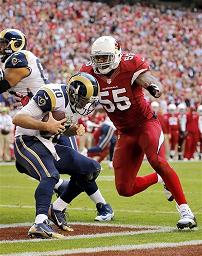 Only four players from the 2000 draft remain active in the NFL. Three of them—Tom Brady, Sebastian Janikowski, and Shane Lechler—play positions at which longevity for high performers is not unusual. The fourth, Abraham, has been a model of health on the back end of his career, playing in 110 of his teams’ last 112 regular season games at a more physically rigorous position.
Only four players from the 2000 draft remain active in the NFL. Three of them—Tom Brady, Sebastian Janikowski, and Shane Lechler—play positions at which longevity for high performers is not unusual. The fourth, Abraham, has been a model of health on the back end of his career, playing in 110 of his teams’ last 112 regular season games at a more physically rigorous position.
Last off-season, Atlanta decided that despite coming off a ten-sack season, and despite 32.5 sacks over the previous three seasons combined, Abraham did not merit his scheduled $7 million in compensation. Several teams showed interest, but he ultimately inked with Arizona for a meager $4.6 million over two years.
For that paltry investment, Abraham put opponent quarterbacks on the ground 11.5 times last year, the fourth-highest sack total of his illustrious career. Despite modest escalation of his 2014 compensation to $3 million plus makeable incentives—and despite a potential suspension due to pending DUI charges—he represents great value yet again if he can dip into that fountain of youth one more time.
Worst Contract: Larry Fitzgerald
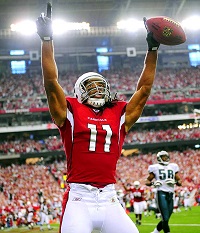 Believe me when I say that it breaks my heart to pick Fitzgerald in this spot. He was without a doubt the greatest athlete I witnessed as a student at the University of Pittsburgh, and when his NFL career finally winds down, the Hall of Fame surely awaits. Moreover, Arizona has doled out a number of iffy deals over the years, and I’d much rather write about almost any other.
Believe me when I say that it breaks my heart to pick Fitzgerald in this spot. He was without a doubt the greatest athlete I witnessed as a student at the University of Pittsburgh, and when his NFL career finally winds down, the Hall of Fame surely awaits. Moreover, Arizona has doled out a number of iffy deals over the years, and I’d much rather write about almost any other.
But that seven-year, $113 million extension is too nutso to overlook, and it was from the moment he signed it. At the time, the top of the wideout market touched maybe $11 million per year; Arizona not only reset the bar for the position by nearly half over again, but they managed to create a new class of contracts for all elite non-quarterback players. It’s one thing to do that for a player like Calvin Johnson just entering his prime, and another for a veteran with as much wear on his body as Fitzgerald. It seemed clear at the time that he wouldn’t play out more than a few seasons at best before the dollars grew out of whack with his ability to stay productive.
Yes, he possessed all the leverage in negotiations going back to his ill-configured rookie contract, which led to a no-franchise clause in his robust second contract, which led to the insanity of his current deal. Yes, following the 2010 season he put on display maybe the most dominant postseason performance that I’ve ever witnessed by any player at any position. Yes, he is the best thing to happen to Arizona Cardinals football since the founding of the State of Arizona, the invention of the sport of football, or the evolution of the cardinal. Those details fade when a combination of age and surrounding talent reduce his performance to the merely mortal, and the baggage of his contract looms heavy over the present and future roster composition of his team.
2013’s Best and Worst Cardinals Contracts:
2013 Best Contract: Daryl Washington (facing suspension)
2013 Worst Contract: Larry Fitzgerald (see above)
Click Here to Check out OTC’s other Best and Worst Contracts from around the NFL!
[adsenseyu2]
[adsenseyu4]
[subscribe2]
Daryl Washington Suspended for the Season
[adsenseyu1]
Arizona Cardinals Linebacker Daryl Washington has been suspended for the 2014 season due to another violation of the substance abuse policy. The year long suspension should be a costly one for Washington.
He will lose out on his entire base salary in 2014, which was set at $2,900,000. Per the CBA any drug violation also requires that you forfeit your share of signing bonus money attributed to that season. For Washington that is another $456,765 which is the cap charge remaining from his $2.5 million signing bonus that was paid in 2012. Washington also had his contract tweaked in 2013 to move a $10 million option bonus from the end of the 2013 season to the start of the 2014 season. That should make his $2.5 million proration from the option bonus also subject to automatic forfeiture. Washington was suspended for 4 games last season and lost $564,706 in salary and forfeited another $216,177 in bonus money already paid.
For the Cardinals this news had to be tremendously disappointing. The Cardinals extended Washington in 2012 when he had two years remaining on his contract. They increased his salary over those two years by about $6.3 million with another $13 million coming his way in 2014, technically the first extension season of the contract. In that three year timeframe he will have missed 20 games due to drug suspensions and lost just under 1/3 of his salary to those suspensions.
Usually cap relief does not come right away in these situations. Once Washington can be officially moved to the Reserve/Suspended list, which usually occurs after final cutdowns, $2.9 million will be gained in cap room for the 2014 season. The forfeited money is applied as a credit to his contract in each of the remaining seasons, so no relief is usually seen until the year following the suspension. Perhaps that will be different in this case, but history would indicate that it is gradual relief that will be felt by the organization.
When Washington returns from suspension he will still have $12.67 million in potential salary that he can earn from 2015 through 2017 if his current contract is left untouched. But it is situations like this one which is why teams are often hesitant to extend players early and then open themselves up to these scenarios. For every Patrick Peterson that people say are underpaid and deserve raises there is a Daryl Washington whose off the field decisions have cost the Cardinals millions of dollars and their starting linebacker for the entire 2014 season.
[adsenseyu4]
[adsenseyu2]
[subscribe2]
Free Agency Thoughts: Arizona Cardinals
[adsenseyu1]
Key Additions: Jared Veldheer ($7M per year), Antonio Cromartie ($3.5M), Ted Ginn ($3.3M),Ted Larsen ($1.3M)
Key Re-Signings: Matt Shaughnessy ($2.2M per year), Jay Feely ($1M), Frostee Rucker ($1M)
Key Losses: Karlos Dansby (Browns), Andre Roberts (Redskins)
Major Cuts: Daryn Colledge ($5M cap savings- June 1)
Free Agency Thoughts:
The most important thing for the Arizona Cardinals to do this offseason was improve the offensive line and they did that with the signing of Veldheer who was one of the better bargains at the position. Veldheer was injured most of last season, but he is an above average player and they got him at a reasonable cost. The structure of the deal was important. Because of cap constraints the Cardinals needed to have Veldheer at a low cap charge, but rather than doing it strictly through signing bonus money they guaranteed a portion of his second year salary and dangled a third year guarantee. If injuries strike they will carry just $3.75M in dead cap in 2016, which is a dramatic departure from the structures used for Will Beatty of the Giants and Sam Baker of the Falcons signed just a year before with similar cap constraints.
Signing Antonio Cromartie on a one year low cost contract could prove to be one of the better signings of the offseason. Because the Cardinals already have capable cover guys there is really no downside. Two years ago Cromartie was a legit Pro Bowl quality player. He had hip problems in 2013 and I think there is a real fear that last year was the beginning of what could be a fast decline, but this is a situation where taking the risk is well worth it.
While I do think the contract for Ted Ginn is a bit rich, it may just be a one year contract. Either way it’s a more efficient deal than what Roberts signed for in Washington. While Ginn will never be a great receiver teams do have to respect his speed and he can put up a big play late in the game. His ability to change field position on special teams is at the top of the NFL. In a competitive division like the NFC West those types of plays may be more meaningful.
Losing Karlos Dansby will be a blow to the defense but there is no way the Cardinals could justify spending the amount of money the Browns spent on Dansby. $6 million a year for a player on the wrong side of 30 is simply too high to even consider. The odds of Dansby recreating his 2013 season are pretty remote.
Overall Grade: A-
I think the Cardinals 2014 offseason is a great example of the way a competitive team should approach free agency. They identified a weakness and grabbed a very strong player to help solidify the position. They found veterans with some upside that can augment the talent base in place without really damaging future salary cap situations. They signed a number of depth players that should contribute none of whom would hurt the team if they flop. The wisely used the June 1 on Daryn Colledge which will give them an operational budget for the regular season that could be used in part to pay for an extension for Patrick Peterson or to try to find offensive line help when cuts begin late in the summer.
[adsenseyu2]
[adsenseyu4]
[subscribe2]
